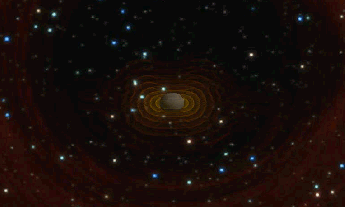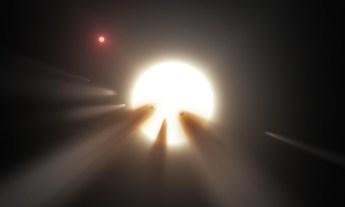
A new initiative will allow astronomers to search a million stars for intelligent life. With tens of billions of stars in the Milky Way, might we finally win the numbers game?
It’s little more than five decades since we turned our sense of awe and wonder at the universe into a concerted effort to find life beyond our own planet. So far, those efforts have yielded few rewards — radio silence from an inconceivably vast universe, seemingly devoid of extraterrestrial intelligent life. But that’s no reason not to continue the search, say backers of Breakthrough Listen, the latest and largest initiative to search for life among the stars. “It’s humanity’s boldest attempt ever to determine whether or not we are alone as intelligent beings,” says Andrew Siemion, director of UC Berkeley’s SETI research center and one of the project’s leaders (TEDx Talk: Beyond the singularity). For the next ten years, the world’s most sensitive telescopes will scrutinize a million stars and a hundred nearby galaxies, helped by tens of thousands of eager volunteers who have formed the world’s largest supercomputer dedicated to the search for extraterrestrial intelligence. Here’s the deal.
We’ve looked for ET before, of course. Early efforts focused on two stars. In 1960, Cornell astronomer Frank Drake tuned the 85-foot radio telescope of the National Radio Astronomy Observatory to 1420 MHz and waited. And waited. From April to July, six hours a day, he listened to emissions from two sun-like stars, Tau Ceti and Epsilon Eridani, considered likely candidates to have habitable planets and singled out by influential astronomers Giuseppe Cocconi and Philip Morrison as a good place to start a targeted search for intelligent life. Drake used just a single 100 Hz channel receiver in his efforts to detect signs of interstellar transmission and, well, he heard only static. Nonetheless, his was the first attempt to use the techniques of radio astronomy in the search for extraterrestrial intelligence (SETI). Since those early days, other projects have followed suit, such as the SETI Institute’s Project Phoenix, which examined some 800 stars over the course of nearly a decade from 1995. (Watch TED Prize winner Jill Tarter describe some of this work in her 2009 TED Talk, Join the SETI search.)
Is there anybody out there? When Drake first began his observations in the 1960s, he focused on a small part of the electromagnetic spectrum — 21 cm or 1420 MHz. This is the frequency at which the most abundant element in the universe – hydrogen – emits radiation and, according to Cocconi and Morrison in a hugely influential 1959 paper in Nature, is the optimum frequency to search for ETI. According to the astronomers’ reasoning, another technologically advanced civilization might reasonably expect life to develop near our sun, and may have set up a “channel of communication” that we might one day identify. At this frequency, signals can travel relatively unhindered across interstellar distances and aren’t masked or attenuated by interstellar dust and water vapor in the atmosphere, allowing an alien signal to stand out. This so-called hydrogen line lies within a broader electromagnetic window — the terrestrial microwave window — between a few hundred MHz and 10 to 15 GHz, roughly between FM radio broadcast and satellite operating frequencies. “It’s kind of a special window where we can see very easily out into the cosmos,” says Siemion. “It’s a very interesting place to do our searching.”
Bigger, better, faster searches. Early radio telescopes allowed observers to tune in to only one frequency at a time, but modern computing allows astronomers to listen in to billions of channels simultaneously. “In the last two to three years, computers have gotten fast enough that you can build an instrument that can search that entire part of the radio spectrum all at once,” says Siemion. “Rather than having to tune around with a receiver and kind of pick and peck at different parts of the spectrum, we can search that whole chunk at the same time, or at least fractions of it, depending on which radio telescope we use.” Now, the world’s largest radio telescopes, the Green Bank telescope in West Virginia and the Parkes telescope in Australia, will be listening. Together, these telescopes are 50 times more sensitive than those used in the past, and the project leaders say it will cover ten times more of the sky than previous programs. All told, it’s our best shot yet at solving what astronomers describe as a numbers game. As Drake said in a 2010 BBC documentary, “we’ve looked carefully at only a few thousand stars on a very small number of channels that are possible in the electromagnetic spectrum. We have to look at 10 million stars before we have a good chance to succeed.” Or, as Cocconi and Morrison concluded in 1959, “The probability of success is difficult to estimate; but if we never search, the chance of success is zero.”
How to separate the signal from the noise of billions of channels. Berkeley’s SETI program has already laid the groundwork for processing the vast amounts of data the project will produce as it searches the sky. In 1999, Berkeley launched SETI@Home, a “distributed computing” program that allows personal computers to process chunks of data when they’re in sleep mode. It was set up with the single objective of analyzing data from the Arecibo telescope in Puerto Rico and currently has more than 1.6 million participants. With the launch of Breakthrough Listen, more data than ever is now being distributed to a growing network of home computers, in effect, creating the world’s largest supercomputer.
Making contact will likely be nothing like the movie Contact. If Breakthrough Listen does hear something, the first priority will be to verify the findings. That takes time, so don’t expect scientists to be making breathless announcements any time soon — at least if the response to this unusual signal, picked up by a Russian telescope in 2015, is anything to go by. “That some signal will be absolutely conclusive, that we’ll know immediately that we’re seeing advanced technology? That’s probably not what will happen,” says Siemion. Nonetheless, if we are successful, the impacts could be far-reaching, not least because it would help to confirm whether humans are unique — or just one of many technologically advanced civilizations. “Statistically speaking we’re either going to find a bunch or we’re going to find zero,” says Siemion. “The only thing weirder than there being only one example of intelligent life anywhere in the universe is for there to be only two examples of intelligent life anywhere in the universe.” So perhaps, when the project draws to a close in 2025, the question will no longer be “if” another extraterrestrial civilization exists, but “how many?”












